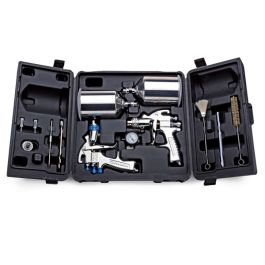Deleted Member
Guest
That's a cool set up for the compressor! Mine is definitely less sophisticated.Thanks Flecker! This is what I have for my air drying. Out from the compressor the line goes to a transmission cooler, then to a water separator, and then into the tank. The line going into the tank stays at ambient temperature, and I have noticed when I open the drain valve on the tank the next morning, hardly any water comes out, where as before when I would crack the drain valve open in the morning, a whole bunch of water would blast out.
I also have a water separator and a regulator at my air hose reel about 40 feet away. I'll pick up some of those disposable filters, and that spectrum gun and give it a go :)
Any suggestions for primer and single stage paint that would provide good rust protection, and scratch resistance? Not body panels, but for stuff like car parts, roll cage, tool carts, and just general steel items? Doesn't need to have a high gloss look. Preferably not too expensive. Would something like tractor paint work? LOL

 It's always condensate that gets water in the compressors... I live where it's warm/ cold extremes and it tends to aid in the compressor's getting moisture in them.
It's always condensate that gets water in the compressors... I live where it's warm/ cold extremes and it tends to aid in the compressor's getting moisture in them.As for primer's and paints... There's a ton of options. I like these primers for general use:
It's an easy to use, direct to metal (dtm) sandable high build... Keep in mind it really depends on the size of the job too. For little knicky knacky things like small parts I will just rattle can with a 1k (provided it's safe for various paints). For bigger jobs I may start with a self etch primer or epoxy primer (for jobs I know I am going to put filler over) on bare metal, then a 2k for final/ sealer, then paint. It really just depends on the project.
Of course high dollar primers aren't always necessary, nor do you need the volume of a gallon of it at all times. Thus the rattle cans when ya like.
As for durable top coats, again that depends too... for just a get er done single stage with hardener's/ urthane mix my go to is restoration shop or speedkote. The price for a quart is roughly 55-60 bucks and a gallon is probably 150-160. Enamels tend to be a bit cheaper, and just as durable but don't have the same uv protection that the urethane single stage would offer. BUT, they are easily cut and buffed and will literally last for 25 years or better if treated right. I still see a rig rolling around town I sold 20 years ago with a single stage enamel paint job on that looks just as good as the day I sold it.

Of course there's cheaper options too for the small stuff, like the off the shelf quarts from o'reilly's. It's a dupont brand that has worked pretty good for me here and there... limited colors though.
And right on up from that is ppg, nason, eastwood (they actually have an great single stage). There's a lot of options... again it really just depends on the project. I wouldn't waste a ton of money on a 95 civic hatchback... or even an old sammy, but I might spend a few bucks for an older square body or mustang. The budget typically matches the project desired end results.

And sure, tractor paint works great for some applications! To be honest I'm not a huge rustoleum fan... it's so brittle and fades/ chalks up super easy without constant attention. It works for a one and done deal, but I don't want to have to think about it when I am done. For the low budget, absolute quickie paint... THIS: is what I would grab.
Valspar/McCloskey 18-4431-14-07 Tractor & Implement Paint, White ~ Gallon
www.hardwareworld.com


